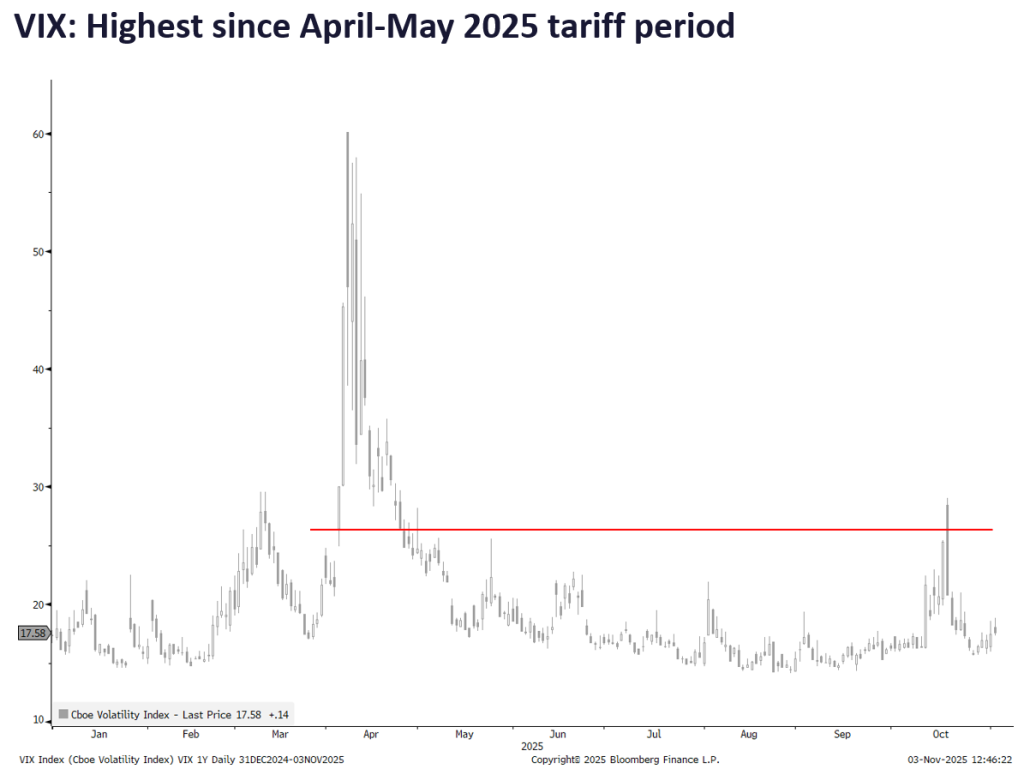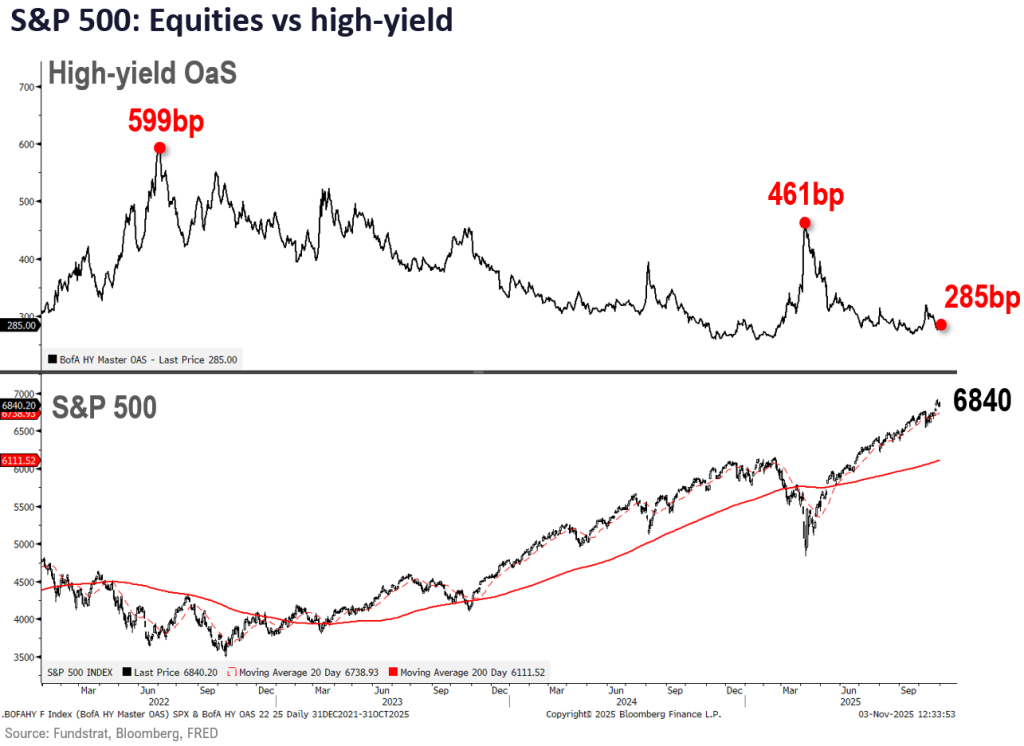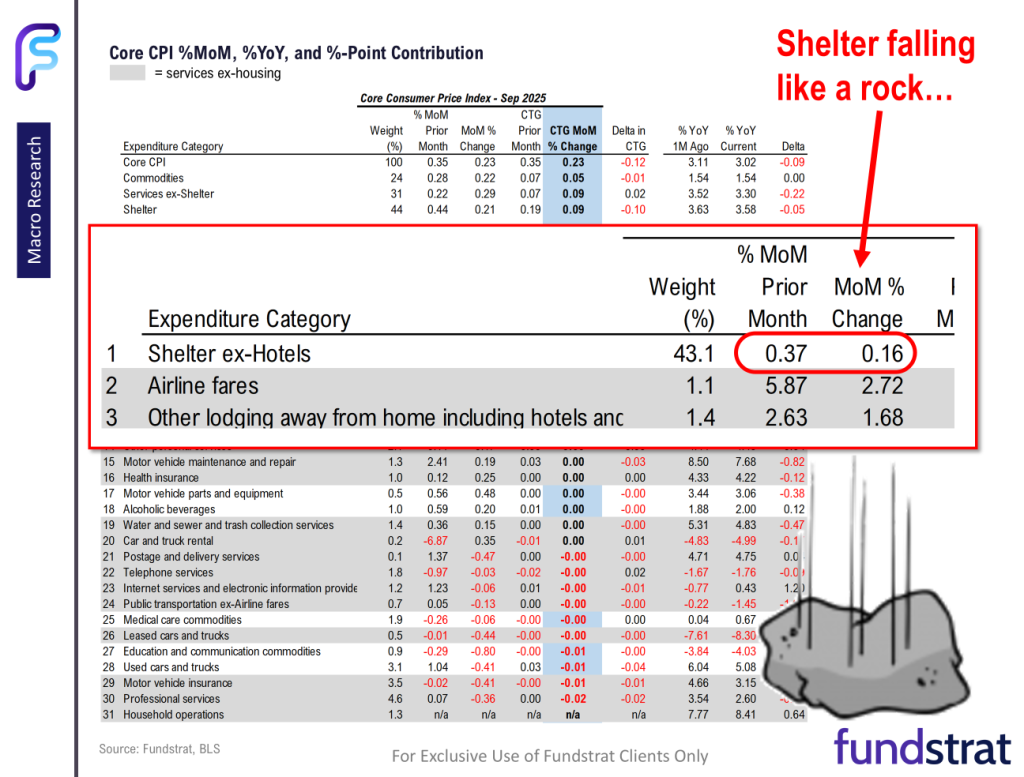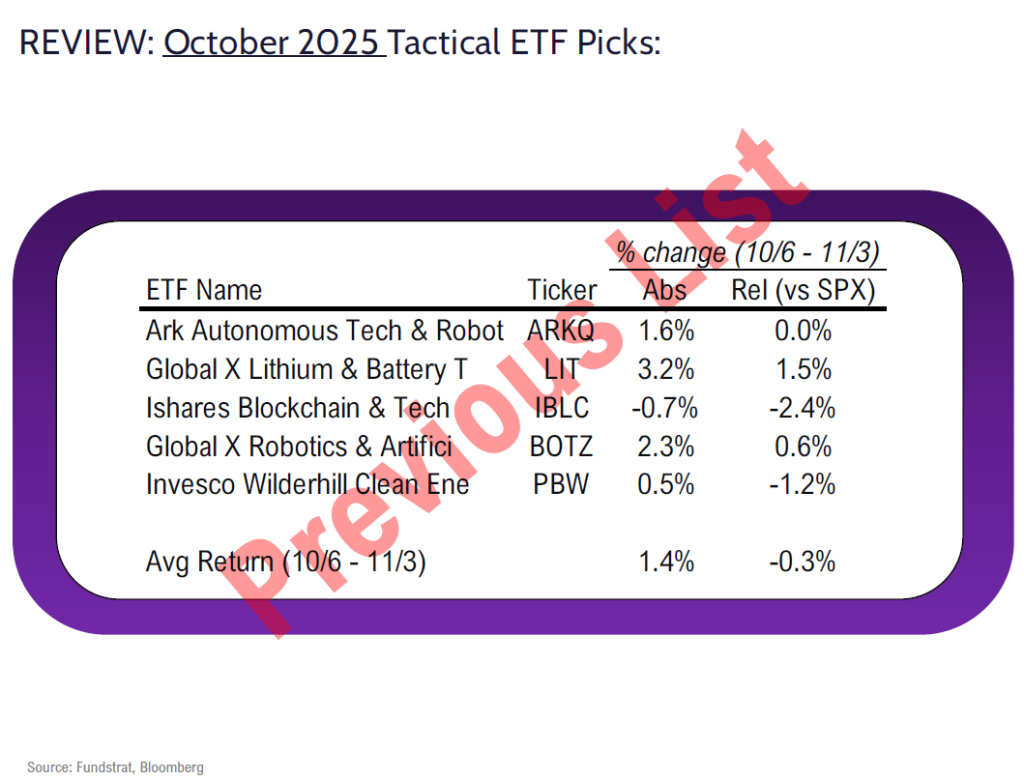Please CLICK HERE to download the sector allocation report in PDF format.
Market Recap
Over the past month, despite the persistent bearish sentiment, we expected October to be an “up”-tober. The month lived up to that name, with the S&P 500 climbing 2.3% and the Nasdaq Composite rising 4.7%.
As we have noted in the past, government shutdowns do not typically have immediate impacts on the stock market unless they are prolonged and cause economic damage. Nevertheless, when the U.S. federal government shut down at 12:01 a.m. on Oct. 1, many investors began the month with a slightly higher level of anxiety. Betting markets suggested the likelihood that the shutdown could continue into November, and that has held true.
Government shutdowns suspend all operations deemed as non-essential. This includes the release of all macroeconomic data. This time was no different, with one exception that we will discuss later.
Due to the dearth of fresh economic data this month, investors ended up paying more attention to other developments, and arguably reacting more strongly than they might otherwise have. We saw this on Oct. 10, when President Trump responded strongly on social media to a potential escalation in Chinese export controls on rare earth materials by threatening a “massive increase of tariffs on Chinese products.” This created a sort of PTSD (post-traumatic stress disorder) reaction, bringing back memories of the Liberation Day aftermath.
Stocks plunged, and the VIX spiked 32% – the 39th highest spike in the history of the VIX. Volatility rose to its highest level since Trump launched his tariff broadside in April and May – though still significantly lower than its springtime peak.

This can be viewed as a constructive signal, because VIX spikes usually happen at the lows. The chart below shows how this trend has held up in 2025. On the four occasions that the VIX spiked to a similar or greater degree this year, the S&P 500 hit a local bottom each time.

Since 1990, VIX spikes of 30% or more showed median one-month forward returns of 2.8%. In the context of this latest spike on Oct. 10, this translated into the likelihood of the S&P 500 gaining 200 points or more by mid-November, hitting 6,752. The S&P 500 achieved well ahead of schedule. As seen in the table below, this pattern also supports our base case for a year-end target of 7,000 for the S&P 500.

Credit-related events
The lack of government data in October also gave investors more attention to focus more on the health of U.S. credit markets. Since September, we have seen multiple credit-related events in the headlines.
- On Sept. 10, Tricolor, a provider of subprime auto loans, filed for bankruptcy.
- On Sept. 29, First Brands, an after-market auto parts company, collapsed amidst reports of substantial debt and the use of opaque off-balance-sheet financing.
- This continued in mid-October, when Western Alliance and Zions Bank reported large losses in distressed commercial mortgages from a shady entity called Cantor Group (completely unrelated to Cantor Fitzgerald).
- On Oct. 22, PrimaLend, another provider of subprime auto loans, filed for bankruptcy.
These events gave many investors PTSD of a different sort, with some recalling the 2008 global financial crisis (GFC). It likely did not help when JPMorgan CEO Jamie Dimon remarked metaphorically that “there is never just one cockroach,” suggesting that there might be more credit events that have yet to emerge.
Our view is that if there are credit problems brewing, we should see it in high-yield spreads, but we did not. Those spreads hardly budged in response to the events mentioned above, remaining largely steady.

To illustrate the kind of widening spread we might expect, it might be useful to revisit the GFC. Before the market topped in 2007, high-yield spreads were just under 300 bps (just about where they were on Oct. 22 after the PrimaLend announcement). On Nov. 21, 2007, about a month after the market topped, spreads doubled to 600 bps. That rapid doubling in the high-yield spread back in 2007 was a warning sign. To us, it does not make sense to worry about a repeat of the GFC until we again see a similar doubling of high-yield spreads.

The Federal Reserve
As we mentioned earlier, the federal shutdown resulted in no government economic data being released in October. This left the Fed without much of the data it uses to make policy decisions.
The one exception to that was the consumer price index. Because the Social Security Administration is required by law to calculate the cost-of-living adjustments for 2026 by mid November, the Bureau of Labor Statistics in turn was belatedly ordered to produce the CPI report the SSA needs for its calculations. Thus, the September CPI report was released on Oct. 24, nine days after its originally scheduled date but still ahead of the FOMC meeting on Oct. 29.
The CPI report showed that inflation is falling like a rock. The key to that trend was shelter, with the shelter-excluding hotels MoM component rising just 0.16% in September, well under 2% annualized. Previously this component had been running at roughly 0.3% to 0.4% – equivalent to an annualized rate of 4% to 5%. Such a huge decline from a component that comprises 43% of CPI will be difficult to offset, so that really means that inflation in general is also falling like a rock.

Though no government jobs data was released in October, non-government sources suggested that the labor market is leaning soft. Linkup.com forecast that jobs numbers for October would ultimately turn out worse than they were in September. The Carlyle Group released their own estimate of jobs, and it showed an estimated 17,000 new jobs created, way down from September.
Put together, these observations were enough to convince the Federal Open Market Committee (FOMC) to once again cut rates by 25 bps, as expected. Equities responded negatively during the post-meeting press conference when Fed Chair Jerome Powell told reporters during the customary post-FOMC press conference that another rate cut in December is “not a foregone conclusion.”
However, he then acknowledged the view that tariffs are in effect “one-time” price increases rather than inflation. He further suggested that when excluding the effect of tariffs, implied PCE is likely now around 2.3%-2.4%, which he described as “not that far off” from the central bank’s 2% target. “I wouldn’t say [rates] are accommodative now,” he added, further bolstering the case for more cuts as he noted that job growth is currently “close to zero.”
To us, it is clear that softening labor markets will determine the path of Fed policy over the next few months. Notably, job-market softness has been partly the result of advances made by AI. Because corporate profits for companies leveraged to AI benefit from this shift, there is a likelihood that equities could rise even as the job market weakens, further pushing the Fed to remain dovish. After all, the Fed’s mandate is to support labor markets, not target corporate profits.
Looking forward
As we approach the final weeks of 2025, we remain constructive on the equity market. Based on our conversations with clients, many have expressed doubts about the persistence of the market rally since the Liberation Day selloff, especially amid the “wall of worry” surrounding the government shutdown and a hawkish Fed. This concern is understandable, as the market has gained for six consecutive months since April.
In fact, our team identified six historical precedents in which the market was up for six straight months heading into November. Interestingly, the data show that the market tends to carry its strength further into November and December:
- Median Return: +2.5% for November and +2.4% for December
- In 5 of the 6 instances, the market finished higher by year-end (1936 was the only exception).
Admittedly, 2025 presents some unique circumstances, particularly regarding the government shutdown. However, with the local elections behind us, we could see progress on Capitol Hill. In fact, Polymarket now prices in that the government shutdown could end by November 13, much earlier than the prior consensus estimate of late November. Once the shutdown ends, many of the negative headwinds—such as liquidity pressure—could begin to ease. Hence, the market may remain choppy in the near term but could drift higher afterward.

Strategic Sector Ratings
In October, while major indices made new highs, overall market participation weakened. Reflecting this, Mark downgraded 4sectors in this month’s sector allocation update:
- Financials / Discretionary: Overweight → Neutral
- Real Estate / Materials: Neutral → Underweight
Financials: Financials traded sideways from July through October. The sector entered earnings season with relatively low expectations given its underperformance versus the S&P 500. Although earnings were generally strong, continued hawkish Fed rhetoric and concerns around private credit weighed on sentiment. Technically, Financials broke their intermediate-term uptrend. While Mark expects a potential bottoming process over the next 2–3 weeks, the sector was downgraded to Neutral tactically for now.
Consumer Discretionary: October was a tough month for Discretionary. Although the cap-weighted Discretionary sector rose +2.4%, the equal-weighted version actually fell –4.2%. Strong gains from AMZN and TSLA lifted the cap-weighted index, but the broader retail complex came under heavy pressure, partly reflecting tariff-related impacts showing up in earnings. Mark generally views sectors from an equal-weighted perspective, and the equally weighted Discretionary relative to the equally weighted S&P 500 has made no progress over the past five years. Therefore, he downgraded it to Neutral until a clearer trend emerges.
Basic Materials: Mark upgraded Materials to Neutral back in June, anticipating strength in precious metals and a potential summer rebound. However, the rebound never materialized. The Fed’s recent “hawkish cut” boosted DXY and added further pressure, combined with a correction in precious metals. Materials ended up being the worst-performing sector in October, and the equal-weighted version underperformed the equal-weighted S&P 500 even more sharply. Zooming out, this relative weakness has persisted for three years, and technically there are still no signs of stabilization. As a result, Mark downgraded Materials to Underweight.
Real Estate: The sector has essentially moved sideways since May. As one of the most rate-sensitive areas, Real Estate fell sharply following the Fed’s hawkish cut. Its relative pattern versus the equally weighted S&P 500 resembles that of Materials—and in some ways is even worse, showing no signs of relative strength recovery over the past 18 months. Hence, Mark downgraded it from Neutral to Underweight.

Tactical Ranking
Market dynamics in October largely extended September’s trends, so tactical rankings saw limited changes:
- Real Estate, Materials, and Consumer Staples remained among the weakest-performing sectors, unchanged from last month.
- Technology and Industrials stayed at the top, while Energy climbed into the top 3 as it regained strength in late October and is favored by our DQM quant model.
- Utilities, however, dropped from top 3 to #8 due to the weakness since mid-October. Despite its low DQM ranking, part of this is valuation-driven—historical comparisons might not fully capture the impact of AI-related energy demand.

Compared with last month, our overall allocation adjustments were modest. Sectors with weight increases are:
- Energy +1.5%
- Technology +1.0%
- Communication Services +0.2%
- Consumer Discretionary +0.1%
Sectors with weight decreases are:
- Utilities –1.7%
- Financials –0.8%
- Healthcare –0.2%
- Consumer Staples –0.1%
- Industrials –0.1%
Relative to the benchmark index:
- We remain heavily overweight cyclical sectors, except Basic Materials.
- Technology continues to be our most overweight sector.
- Energy is now overweight following recent momentum improvement.
- We maintain zero allocation to Basic Materials and Real Estate, and a reduced weight in Consumer Staples.
- We currently maintain a market weight stance on Healthcare and Utilities

Updated ETF Picks
From October 6 to November 3, our five recommended ETFs gained +1.4% on average, trailing the S&P 500 by 0.3%. The worst performer was IBLC, down –0.7%, affected by overall crypto-market volatility and underperforming the S&P 500 by -2.4%.

For this month’s ETF picks, Mark decided to add back IBB and replace BOTZ and ARKQ with DRIV:
- IBB was temporarily removed last month as it approached strong short-term resistance built in 2024. After successfully breaking through that resistance, the technical setup has turned attractive, prompting its reintroduction.
- DRIV remains trending up sharply and shows no evidence of trend deterioration of any sort. Gains to challenge 2021 peaks look likely which lie near $32.36. While this week has given way to some minor “backing and filling” (Filled gap from last week) this has not resulted in any trend damage and this has risen six straight months off the April lows Neither weekly, nor monthly DeMark exhaustion signals are present, and this should push higher to challenge all-time highs which might prove to be a stronger area of resistance. At present, this is technically attractive.
Updated Five ETF Picks:
- iShares Biotechnology ETF (IBB)
- Global X Lithium & Battery Tech ETF (LIT)
- iShares Blockchain and Tech ETF (IBLC)
- Global X Autonomous & Electric Vehicles ETF (DRIV)
- Invesco Wilderhill Clean Energy ETF (PBW)




